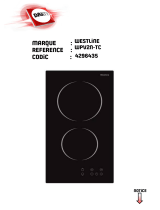SUIVEZ LES AVERTISSEMENTS CI-DESSOUS UNIQUEMENT LORSQU’ILS SONT APPLICABLES À VOTRE MODÈLE
Cet appareil est uniquement destiné à la cuisine résidentielle. Le fabricant ne peut être tenu
responsable des dommages ou des blessures résultant d'une utilisation incorrecte ou pour des
utilisations autres que celles auxquelles cet appareil est destiné.
Ne touchez pas les surfaces chaudes. Utilisez des poignées ou des boutons.
Pour vous protéger contre les chocs électriques, ne plongez pas le cordon ou le corps de l'appareil
dans l'eau ou tout autre liquide.
Une surveillance étroite est nécessaire lorsqu'un appareil est utilisé par ou à proximité d'enfants.
Ne faites pas fonctionner un appareil avec un cordon endommagé ou après un dysfonctionnement ou
une détérioration quelconque de l'appareil. Renvoyez l'appareil à un centre de service agréé le plus
proche pour un examen, une réparation ou un réglage.
L'utilisation d'accessoires non recommandés par le fabricant de l'appareil peut entraîner des
blessures.
Ne pas utiliser à l'extérieur.
Ne laissez pas le cordon pendre du bord de la table ou du comptoir, ni toucher des surfaces chaudes.
Une extrême prudence doit être utilisée lors du déplacement d'un appareil contenant de l'huile
chaude ou d'autres liquides chauds.
Pour débrancher le courant, mettez n'importe quelle commande sur "OFF".
ATTENTION - Ne rangez pas d'objets susceptibles d'intéresser les enfants dans des armoires
situées au-dessus d'une cuisinière ou sur le dosseret d'une cuisinière. Les enfants qui grimpent sur la
cuisinière pour atteindre les objets pourraient se blesser sérieusement.
Ne pas cuisiner sur une table de cuisson cassée - Si la table de cuisson devait se briser, des
solutions de nettoyage et des éclaboussures pourraient pénétrer dans la table de cuisson cassée et
créer un risque de choc électrique.
Nettoyez la table de cuisson avec précaution - Si vous utilisez une éponge ou un chiffon humide pour
essuyer les renversements sur une zone de cuisson chaude, veillez à ne pas vous brûler à la vapeur.
Certains nettoyants peuvent produire des émanations nocives s’ils sont appliqués sur une surface
chaude.
L'appareil doit être installé avec toutes les connexions électriques, d'eau et de drainage
conformément aux codes locaux et en vigueur. Une alimentation électrique standard (240 V CA
seulement, 60 Hz), correctement mise à la terre conformément au code national de l'électricité et aux
codes et ordonnances locaux, est requise.
Instructions de mise à la terre électrique - L'appareil doit être installé et mis à la terre par un
technicien qualifié conformément au code électrique national ANSI / NFPA N ° 70 (dernière édition) et
aux exigences du code électrique local.
Ne pliez pas et ne pincez pas le cordon d'alimentation de l'appareil.
La taille du fusible (ou du disjoncteur) doit être de 20 ampères..
Installation correcte - Assurez-vous que votre appareil est correctement installé, conformément aux
instructions du fabricant.
N'utilisez jamais votre appareil pour réchauffer ou chauffer la pièce.
Ne laissez pas les enfants seuls - Les enfants ne doivent pas être laissés seuls ou sans surveillance
dans une zone où l'appareil est utilisé. Ils ne doivent jamais être autorisés à s'asseoir ou à se tenir
debout sur une partie quelconque de l'appareil.
Utilisez une taille de casserole appropriée - Cet appareil est équipé d'une ou de plusieurs unités de
surface de taille différente. Sélectionnez des ustensiles ayant un fond plat suffisamment grand pour
recouvrir l'élément chauffant de l'unité de surface. L'utilisation d'ustensiles trop petits exposera une
partie de l'élément chauffant au contact direct et pourrait provoquer l'inflammation des vêtements. La
relation correcte entre l’ustensile et le brûleur améliorera également l’efficacité.
Ne jamais laisser les unités de surface sans surveillance à des températures élevées - L'ébullition
provoque la formation de fumées et de débordements graisseux pouvant s'enflammer et créer un
risque d'incendie.





















